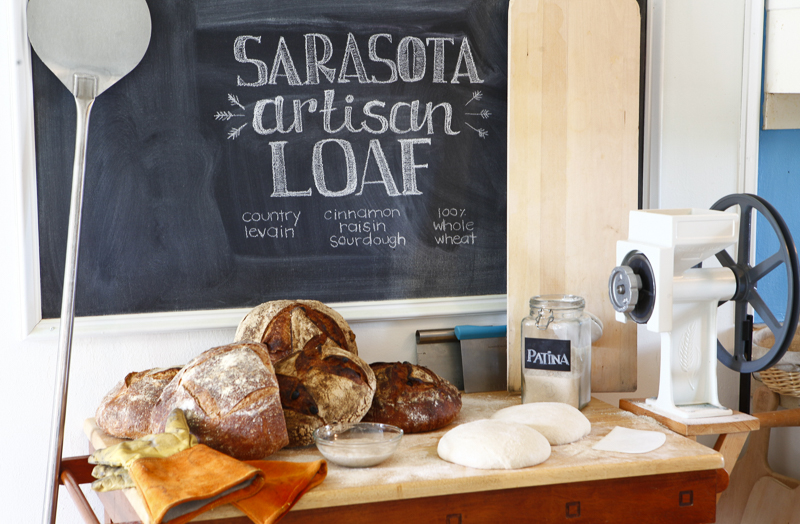Historians and anthropologists hypothesize that sourdough bread was first discovered by accident more than 3,500 years ago in ancient Egypt, with yeast and bacteria cultures forming within unattended rudimentary batter and some adventurous soul deciding that the wise thing to do would be to eat it. Reporting a more tantalizing taste than previous unleavened breads (ostensibly after first reporting not dying), the great sourdough experiment began and continues to this day. Good sourdough cannot be made in isolation. Apart from being one of the earliest forms of leavened bread, sourdough is perhaps the most historical in the sense that the flavor of each loaf comes from its history. Each loaf has a “mother” —an original mixture of flour and water, fermented and maintained as a wild yeast culture, that is dipped into and turned into workable dough for a new loaf. The trademark sour flavor of the bread results from the yeast fermenting in the mother, particularly the accumulation of lactic acid—the offending taste in soured milk. But such a development takes time, and once the desired flavor profile has been found, bakers hold on to it. A strong sourdough starter became something to cherish. In 17th-century France, tireless bakers prided themselves on cooking sourdough only from a mother batch already allowed to rise and fall three times, while in the 1800s, California settlers and miners would carry their mothers on their persons, keeping the cultures alive through their body heat over the long winter months.

SARASOTA ARTISAN LOAF. PHOTO BY GENE POLLUX.
“Making natural sourdough bread is like having a child,” says Russell Anderson, owner and operator of Sarasota Artisan Loaf, which began in 2011 with a 4.5-ton wood-fired oven and the desire to make bread the old-fashioned way. This means maintaining his own mother, just like in the old days, giving it regular feedings of King Arthur flour as the nutrients deplete and keeping a careful eye on the rise and fall cycle. “It can become quite temperamental if not done on schedule,” Anderson says. “Over time, you will begin to understand the nature of how your starter acts. After all, it is a living thing and has a personality.”
“You’re intentionally creating an environment where you want microorganisms to grow,” says James Plocharsky, chef and owner of Small Batch Bakery. “And this micro-ecology can be manipulated to create good-tasting sourdough bread, but can also be ruined by improper handling.” In addition to maintaining the mother through regular feedings of medium-gluten flour (“Yes, good old wheat flour!”), unbleached and unbromated to encourage bacterial growth, Plocharsky controls the temperature to facilitate “optimum fermentation” and, because he’s intentionally growing bacteria, has to carefully maintain sanitation standards to avoid contamination.
This lengthy and vulnerable fermentation process, prone to accident and mishap, is one of many reasons mass production favors non-sourdough breads, but is also key to the diversity in flavor amongst sourdough offerings. “As you become more knowledgeable about the process, there are many techniques to help change the amount of sourness to the loaf,” says Anderson, who keeps his exact method a secret, but is willing to share some basic principles, and he says the key to getting that great sourdough taste is through a process called retarding, slowing the rising process and giving the flavor more time to develop. After that, he doesn’t need much more than a pinch of salt to round it out. On the flipside, Plocharsky aims for just a tinge of sour flavor, eschewing the heavily sour San Francisco tradition by timing the feeding and mixing of his final batch. The leavening yeast will always grow faster than the sour-producing bacteria, so if he pulls from the mother shortly after feeding and mixes in more fresh flour, then he can keep sourness to a minimal level and hit that sourdough flavor that he and his customers prefer.
“There is nothing better than enjoying fresh sourdough straight from the hearth as soon as it's cool enough to handle,” says Anderson, before copping to loving a good sourdough French toast. “The structure of the bread has the ability to withstand the dredging without becoming soggy and the sour notes from the bread really offer a fantastic balance to the traditional French toast sweetness.” Plocharsky says, “I occasionally can't resist tearing into a loaf right out of the oven and slathering with soft, salted butter,” switching gears to reminisce about the perfect chicken salad melt on sourdough. “Thick-sliced to keep it moist, and only lightly toasting so not to bully the delicate complex flavor [with] a scoop of Kara’s Chicken Salad and sliced Swiss.”









